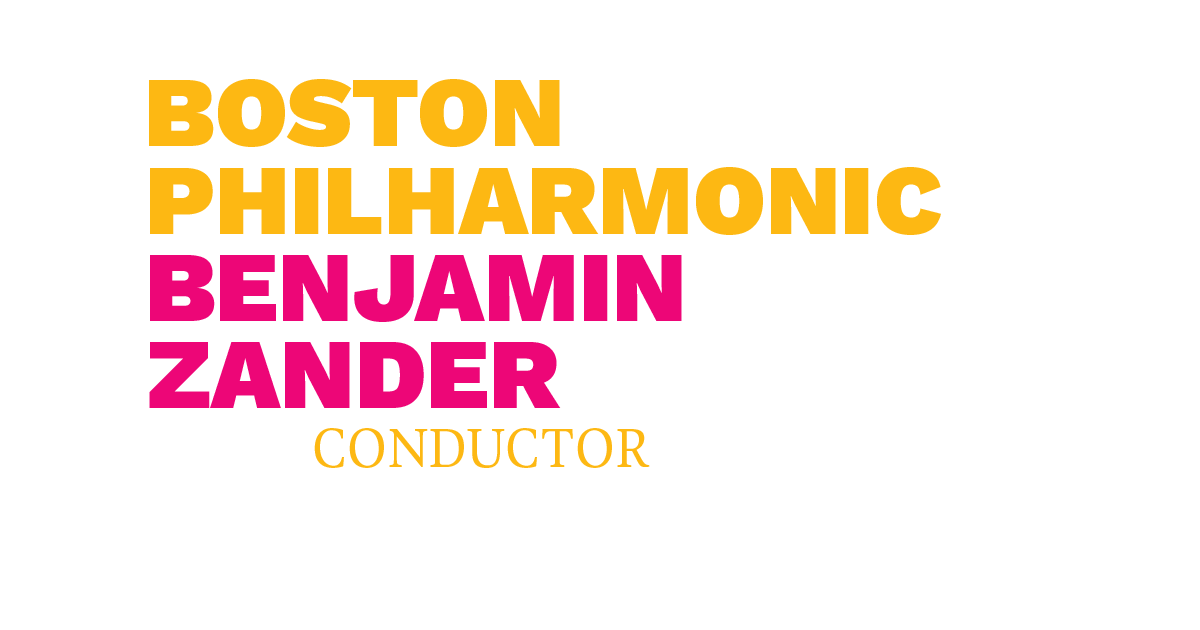Uruguay, Montevideo - Zander never considered conducting as a career until unforeseen and unforeseeable circumstances made it happen. About midway in his career on the podium, he entered on a second career that he probably never expected to. He is a man who is comfortable talking and whose pre-concert lectures often attract an audience as large as the concert itself. In the language of the 19th century he is a "silver-tongued orator" in an age that prefers tweets to oratory, an age that seems happy to abandon complexity and nuance. Zander's eloquence is a tremendous advantage for him when he is working with a youth orchestra, but not invariably so much when he is dealing with jaded and truculent professionals. (I cherish the memory of a prominent musician who spoke to me decades ago about a conductor - not Zander - who asked him to play a certain passage "more spiritually." I don't know if the player was bold enough to say to the conductor what he went on to say to me. "Tell me what you want. I can play louder or softer, faster or slower. But I cannot play more spiritually or less spiritually!" That kind of attitude is not uncommon.)
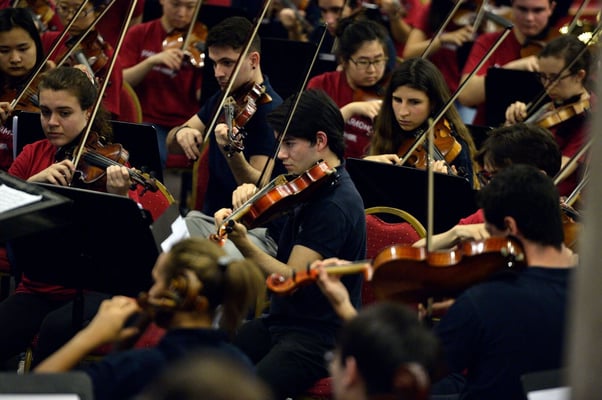
Photo Credit: Paul Marotta
When Zander married the therapist Rosamund Stone, he came to realize that many of his experiences in the musical world could shed light on the wider world of human experience, and, working with her, he co-wrote a book called The Art of Possibility which offered new paradigms for organizing, developing and enriching experience; it has been a consistent best seller for 17 years now and a year ago Rosamund Stone Zander - everyone calls her Roz - produced a sequel called Pathways to Possibility. Their joint work put them on the major lecture and workshop circuit and Benjamin Zander became even better known for what he says than for what he does in music. His work in music helped him develop life skills, and his work as an often highly paid lecturer with an impressive electronic Rolodex helped him in his musical career - he is a major donor both to the Boston Philharmonic and BPYO. To his credit, Zander gives everything he has to each speech he gives - I once heard him give the equivalent of his celebrated TED Talk to a group of less than two dozen high school students in The Netherlands and the level of energy and commitment were the same as he displayed at the World Economic Forum in Davos, Switzerland - and so were the energies he unleashed in his audience.
Not surprisingly, this level of activity has sometimes made him controversial and there are sneering people who dismiss him as a cult figure. But this is neither fair nor accurate; in Boston, at least, Zander is a community figure. Cult figures build a cosmology around themselves, and many conductors have done exactly that. But Zander puts the music and its message first - his ideas are not about himself but about the music. Of course some of his performances are magnificent, and some fall short of the goal - that's bound to happen when you are working with something that is bigger than you are, when you are wrestling with angels.
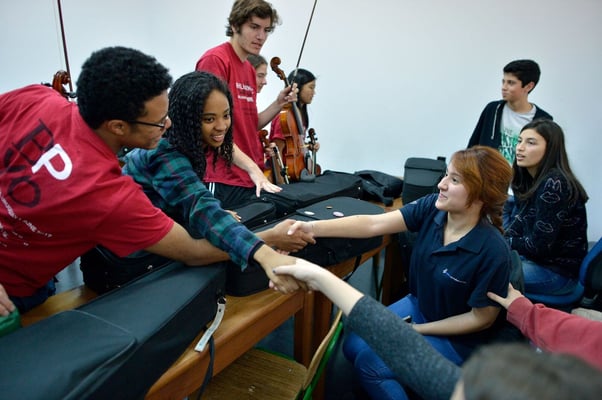
Photo Credit: Paul Marotta
The South American tour, like many of its predecessors, was planned as an exercise in the art of possibility. Zander explained what that means in a tour meeting in Boston that was required of all participants and attended by many parents. He led off not with a precis of the book, although that did come later, but instead read from a recent editorial by David Brooks in the New York Times. Here is part of it - Brooks begins by quoting a piece in The Wall Street Journal by two of President Trump's advisors:
“'The president embarked on his first foreign trip with a cleareyed outlook that the world is not a ‘global community’ but an arena where nations, nongovernmental actors and businesses engage and compete for advantage.'
"That sentence is the epitome of the Trump project. It asserts that selfishness is the sole driver of human affairs. It grows out of a worldview that life is a competitive struggle for gain. It implies that cooperative communities are hypocritical covers for the selfish jockeying underneath.
"The essay explains why the Trump people are suspicious of any cooperative global arrangement, like NATO and the various trade agreements. It helps explain why Trump pulled out of the Paris global-warming accord. This essay explains why Trump gravitates toward leaders like Vladimir Putin, the Saudi princes and various global strongmen: They share his core worldview that life is nakedly a selfish struggle for money and dominance."
Zander wanted this tour to represent an alternative and more moral mode of reality. And he specifically discussed a code of conduct, with particular emphasis on the question of drugs and alcohol. Adults over 21 would be permitted to drink alcohol, although Zander requested that they not do so in the presence of younger players and suggested that they not do so at all because the tour was going to demand undivided attention and fullness of being. There was no room for compromise at all on drugs, zero tolerance, and anyone caught using them or possessing them, would be dismissed from the BPYO and sent home. Everyone signed an agreement to abide by this policy.
No serious violation had occurred on any of the 21 previous tours Zander had undertaken with the youth orchestras, so there was no reason to suppose that there would be one this time. But almost immediately the staff discovered that one player had brought an illegal substance from Boston and had sold some of it to another player; both were escorted to the airport and sent home. The main reaction at the announcement was shock. I didn't hear a single word of support for the two players or a word of complaint about the administrative decision. And I believe that a collective conviction developed that this incident should not stand as the defining episode of the tour. The BPYO entered on each activity whole heartedly, as if it would prove the defining episode - and most of them did, until the next one surpassed it.
And the problem of replacing the players was neatly solved. The whole section in which one of them performed rose to the challenge of doing without, and highly competent replacements were found for the other in Buenos Aires and Montevideo. Zander, and even other members of the section, went out of their way to praise their new South American colleagues who rose to the challenge of performing a difficult and complicated part on the basis of a few minutes of rehearsal.
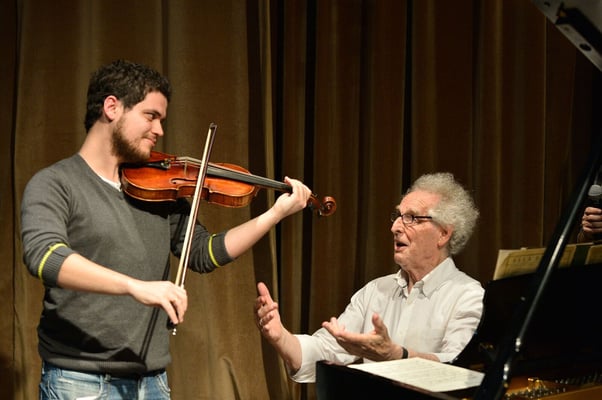
Photo Credit: Paul Marotta
Zander convened two subsequent meetings in Lima and in Buenos Aires. The meeting in Lima was like a getting-to-know-you group session at the opening of summer camp. Nearly everyone was seated on the floor - even the amazing violin soloist In Mo Yang. Zander introduced the staff, some of whom spoke quite personally and eloquently about the life experiences that had brought them to this place.
Then Zander opened the floor, quite literally, and some of the musicians shared their first impressions and early anecdotes. The superb tuba player Frank john talked about a colleague from a side-by-side who wanted to take a private tuba lesson from him and play duets, so John agreed to do so during his "free time" the next day. Horn player Joseph Cradler talked about meeting a busking hornplayer outside a restaurant - the busker had played in the streets with the very young Elmer Churampi, the BPYO's principal trumpet, so Cradler arranged for a free ticket for the concert for this childhood friend. The contrabassonist Jensen Bocco had contributed a reed to a Lima colleague who had a crucial note coming up in the finale of Beethoven's Ninth Symphony.
At the Buenos Aires meeting Zander read a chapter from Roz's book about what can happen when a disaster is recognized as an opportunity to effect change; others then told stories of their own - that's what happens when a pebble is thrown in the water - no one knows where the last ripple will go.
Touring in Europe is quite different from touring in South America. In Europe the BPYO was often following in the footsteps of the composers whose music they were playing, exploring some of the cities where they lived, passing through the landscapes, citiscapes and weather that influenced their music, sometimes eating foods they would have recognized, visiting and performing in the same buildings they frequented and where their works were premiered. This was a profoundly educative experience, and one that was not possible to replicate in South America because the BPYO had programmed no music by South American composers, apart from two short encore pieces by Astor Piazzola.
But it proved much easier to arrange side-by-side events in Latin America, where it is winter - in Europe most of the music schools and youth orchestras are on holiday in June when the BPYO can tour. I have no doubt that Buenos Aires was clamoring for more side-by-sides; there are more than 60 youth orchestras there, most of them operating in disadvantaged neighborhoods. Thanks to Mark Churchill, side-by-sides have become an imporant aspect of BYPO's agenda. Other youth orchestras do tour South America, and in all three cities in Argentina the BPYO followed a tour by the older Harvard-Radcliffe Orchestra, although I doubt that estimable ensemble participated in as many, or any, side-by-side events.
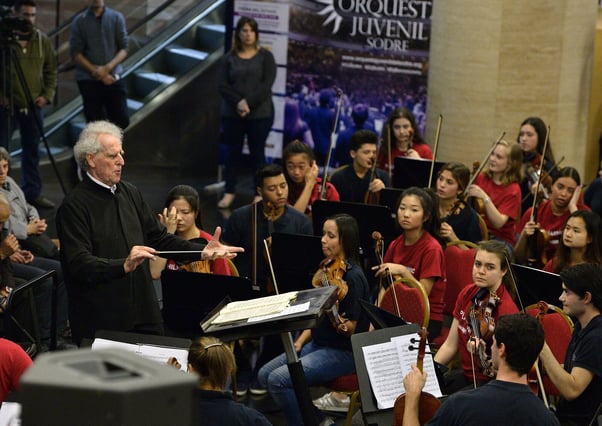
Photo Credit: Paul Marotta
Balancing the schedule is tricky and I will admit that there were days when I felt there were too many activities. More than once I felt I was "experiencing" South America only from a bus-window viewpoint. Also I don't think that rehearsing and playing for 6-8 hours before a concert, plus all the travel involved, is the most fruitful way to prepare for an important performance in the evening, and I can easily imagine how the players' committee of any unionized professional orchestra would respond to many of the challenges these young musicians took in their eager stride.
On the other hand I found each of the side-by-sides I attended extremely rewarding from the human point of view, and what could be more important than that? What I heard about the two I bypassed in order to stay cooped up in a hotel room with my addled brain and Microsoft Word made me sorry I had missed them, especially the one in Buenos Aires that reverberated throughout the rest of the tour.
Zander had already described to me the side-by-side which wasn't like the others- the players subdivided into instrumental groups. But when a small group of us was being driven to the sumptuous summer residence of Victoria Ocampo, the great Argentinian patron of the arts, Zander was distressed when he was told we were passing through the barrio area of extreme poverty the young Argentine musicians had walked from in order to participate in the side-by-side the day before. Immediately he determined that the busses that were to take us to the ferry for Montevideo would need to change their route in order to show this area to the entire BPYO, and when that happened I think many of the young musicians were as devastated as Zander had been. Zander had already reflected on how fortunate the BPYO members are because of the family support all of them have enjoyed and the privileged lives all of them had experienced through their involvement with music. "And it IS a privilege to work in music," Zander insisted.
I have warm musical memories of some of the side-by-sides, because playing music is an exercise in the art of communication. But I think some of Paul Marotta's stunning photographs tell the story better than I ever could because photography, like music, is a non-verbal art- the smiles, the glances, the hugs, the exchanging of instruments, the little demonstrations of virtuosity and caring, said at least as much as the conversations - especially the hugs which persisted from the first side-by-side in Lima to the last one in Montevideo. When I look at Paul's pictures, I hear and feel music. He felt such empathy with the El Sistema players in Buenos Aires that he plans to return and work with them again next year.

Photo Credit: Paul Marotta
Few sights were more joyful than looking at violinist Emily Chen seated on her chair, her legs crossed in front of her in lotus position, acknowledging a deft page turn from her Peruvian stand partner, or watching the string bass section jockeying for position, or enjoying the percussion section which didn't have enough instruments to go around switching them from person to person in the rhythm and tempo of the music - they were like jugglers in a circus or runners in a baton race. Or looking for Chen's little sister, cellist Melanie Chen, the youngest member of the orchestra, whose enchanting smile and physical grace won every heart - she told me she's studying gymnastics as well as cello, and it shows.
In conclusion the South American tour did accomplish a lot of what Zander wanted it to. No, it didn't change the world, but I believe it did affect people positively - the people in the orchestra, the people in the audiences, the people in the side-by-sides. Elisabeth Christensen did the math and reports that the BPYO made meaningful contact with 20,000 people during the tour.
And the orchestra does provide a microcosm of how society ought to function and of how true civilization does; it demonstrates alternate facts that are not fake news. BPYO is a mixture of ages (12-21) and sexes, sexual preferences, religions, races, first languages, ethnic groups - Asian (Chinese, Japanese, Korean), Caucasian, African, etc. It both reflects a changing world (four women and one man in the French horn section) and what has characterized the world through recorded history. Not all of them look forward to careers in classical music - I heard conversations about math, science, medicine, the law, Greek and Roman literature, just about everything but politics, I think.
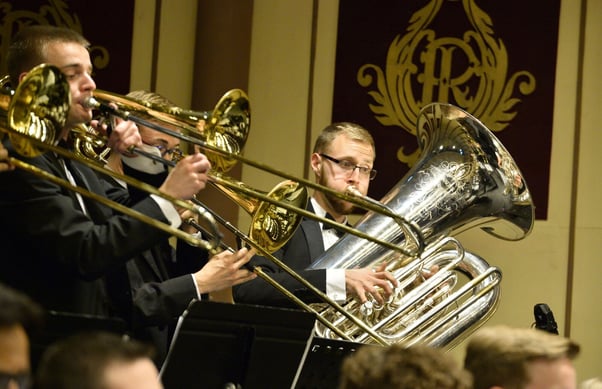
Photo Credit: Paul Marotta
Zander's spoken introduction to encore performances of The Stars & Stripes Forever varied a little from performance to performance but the punchline was always the same. He said the title of Sousa's march referred to the United States flag. "But flags don't tell a story. Instead the flag represents values." And then he enumerated them (this is where the lists varied) - equality, inclusiveness, justice, openheartedness, generosity, joy in life, willingness to be open to new ideas and a sense of adventure." Now the punchline. "These are not American values. These are human values." Spontaneous ovation.
Naturally there are strong differences of temperament and opinion within the orchestra, and occasional clashes of personality, but those differences are placed at the service of a common cause, making music together. To play well, an orchestra musician needs to listen attentively to what others are doing - an effort well worth making in other areas of life. And the differences among the BPYO musicians do not lead to conflict, threats, violence and wars, or senseless efforts to make others over in the image of ourselves. Instead they lead to lively discussions over dinner, chamber music, or gatherings around the table.
